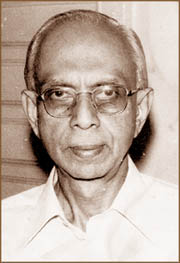T. Nadaraja
Professor T. Nadaraja | |
|---|---|
 | |
| Born | Thambiah Nadaraja 27 December 1917 |
| Died | 20 January 2004 (aged 86) |
| Alma mater | Royal College, Colombo Trinity College, Cambridge |
| Occupation(s) | Academic, lawyer |
| Title | Chancellor of the University of Jaffna |
| Term | 1984–2004 |
| Predecessor | V. Manicavasagar |
Professor Thambiah Nadaraja (December 27, 1917 - January 20, 2004) was a Sri Lankan academic, lawyer and author. He was dean of the Faculty of Law at the University of Ceylon and chancellor of the University of Jaffna.
Early life and family
Nadaraja was born on 27 December 1927.
He later obtained M.A and PhD degrees from the University of Cambridge.[2][3][5]
Nadaraja married Sornam Ammai, daughter of Sir
Career
Nadaraja returned to
In the 1950s Nadaraja was a member of a three-man
Later life
Nadaraja was president of the Sri Lanka branch of the
Nadaraja was awarded
Nadaraja was chief trustee of the Sithy Vinayagar Temple in Colombo from 1945 onwards.[2] He was also a trustee of the Sri Ponnambalavanesvara and Arunachaleswara temples in Colombo.[2][3] These temples had been built by his family.[2]
Nadaraja served as chancellor of the University of Jaffna from 1984 until his death on 20 January 2004.[2][4][5][8] His remains were cremated on 21 January 2004.[9]
Works
- Roman-Dutch Law of Fideicommissa[2][5]
- Legal System of Ceylon in its Historical Setting[2][5]
- The Cult of Siva with Special References to the Dances of Siva[5]
Notes
- ^ Sunday Times. 11 April 2004.
- ^ a b c d e f g h i j k l m n o p q r s t u v de Silva, H. B. (24 December 2004). "Professor T. Nadaraja – brilliant legal mind". Daily News. Archived from the original on 29 June 2011.
- ^ a b c d e f g h i j k l m n o p q r s t u Sanmuganathan, Muttusamy (7 April 2004). "Professor Tambyah Nadaraja, a fine legal mind". Daily News. Archived from the original on 27 May 2005.
- ^ a b c Arumugam 1997, p. 222.
- ^ a b c d e f g h i j k l m n o p q "Welcome Speech at Prof. Nadaraja Oration by Mr. Selvakkumaran, Dean, Fafulty of Law, University of colombo" (PDF). University of Colombo. Archived from the original (PDF) on 17 December 2014.
- ^ Arumugam 1997, p. 95.
- ^ "The Faculty of Law inaugurated the Professor T.Nadaraja Memorial Oration in the University of Colombo". University of Colombo. Archived from the original on 14 September 2012.
- ^ "Establishment of the Jaffna Campus of the University of Sri Lanka". University of Jaffna. Archived from the original on 22 March 2008.
- ^ "Obituaries". Daily News. 23 January 2004. Archived from the original on 26 October 2012.
References
- Arumugam, S. (1997). Dictionary of Biography of the Tamils of Ceylon.
